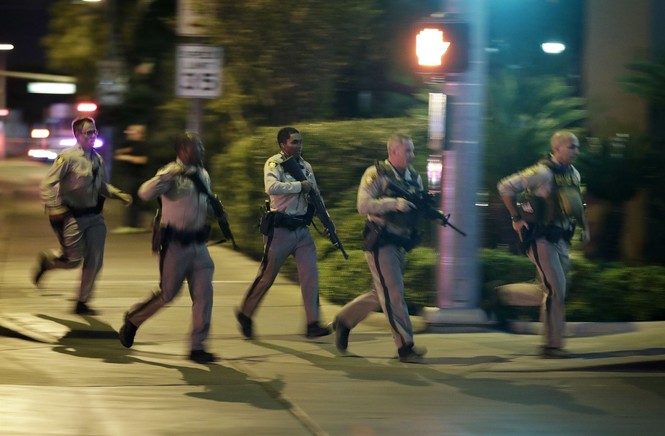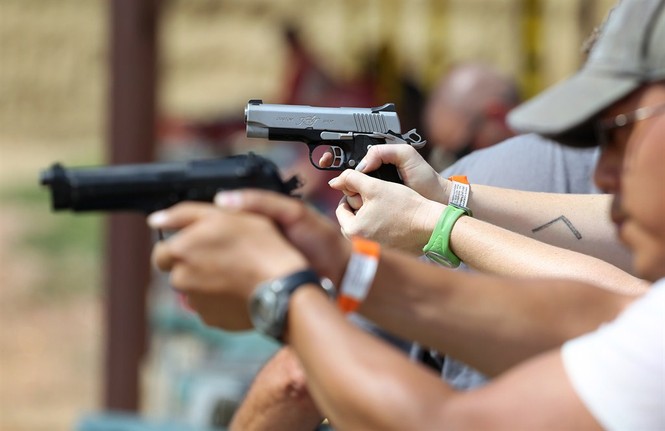Whether a shooting happens at a school or open forum, as we have witnessed in Las Vegas, this general information applies. Originally, I wrote this after my son came home one day last year and said that there was a threat of an active shooter at school. Fortunately, law enforcement and school officials became apprised of the situation before anything serious happened. That presented an opportunity to review with my kids what they should have done had a shooting actually happened. Luckily, they knew what to do.
What about your household?
By no means would I ever consider myself an expert on this topic based on my experience surviving mass shootings. Thankfully, I have no personal experience in this area. This information has been derived over many years through training, study, and personal observation from some of the best in the arenas of self-defense, law enforcement, and military.
There are unlimited scenarios and it is impossible to train for all variables let alone even consider all the possibilities. This is by no means a ‘one size fits all’ approach, but you should have some basic understanding of what to do in the most common of situations.
It is my hope to motivate you to learn more, raise your awareness level and move you from uninformed, to informed, to trained and prepared. Before going further, it is important to note that the Las Vegas shooter held an extreme tactical advantage over his victims and those who would defend them, but the fundamentals of survival remain.
Before getting into tactics, let’s establish some facts.

Fact #1 - You are in a gunfight. If you didn’t bring your gun or you are unable to return fire, then you are simply a potential target in a shooting gallery. The number one rule in a gunfight: Always bring a gun. As it relates to the Las Vegas shooting, the shooter had a near insurmountable tactical advantage; but at the end of the fight, it was a gun that ended the melee.
Recommended
Fact #2 - There is nearly a 100 percent likelihood that both you and your opponent have not done this before. With the internet and videos, it is possible for a shooter to become trained and desensitized to what he would face in a shooting. Ltc. David Grossman has done some excellent research in the area, and I highly recommend his material, starting with the essay, "On Sheep, Wolves, and Sheepdogs."
By not preparing for a gunfight and not bringing your gun, you have given your opponent an extreme tactical advantage, but you can survive.
Fact #3 - Guns and bullets are not magical. Hollywood has given firearms abilities that defy physics and do not exist in the real world. Bullets easily go through walls, glass, and even car doors; however, they can only go through so much before losing energy. Cartridges in magazines do not last forever, especially if fired at a rapid pace. Bullets do not cause things to explode and burst into flames. Most targets are difficult to hit especially when they are moving.
Getting shot will not necessarily kill you. Most gunshot wounds beyond the head and chest are survivable if you are able to control bleeding. As of the time of this writing, 527 people were injured in Las Vegas and roughly ten percent of that number died. Approximately 2.7% of the concert goers were injured or killed. Pointing out these statistics is not to diminish the lives that were lost, but rather to point out that survivability is possible and probable.
Fact #4 - Distance and time are always your friend. Gain as much of both in that order.
Fact #5 - There are three kinds of targets: stationary, moving, and one that cannot be engaged for a variety of factors - the best of which is that it is behind cover or too far away and out of sight. You should move rapidly to be the latter category and avoid being a stationary target at all costs.
Fact #6 - There is no safe time to move. There is only right now.
Fact #7 - It will be loud, chaotic, and bloody. You have to fight through this, overcome the fear that paralyzes human beings, and do whatever it takes to survive.
Fact # 8 - Most mass shootings take place in gun-free zones. If you want to avoid mass shootings, avoid gun-free zones.
Fact #9 - Most mass shootings are stopped by superior firepower or the shooter’s own firearm with a self-inflicted wound.
Fact #10 - It is very difficult for a shooter to effectively engage more than one target at a time. If I'm being shot at, he is not shooting at you, and he has to reacquire a new target after dispensing with the previous one.
A note on tactics.

One very sobering fact must be considered: If the shooter is very close to you, like in the same room, it is likely that you are going to be either wounded or killed. In this situation, you only have the best of two poor choices: die in place or take a chance at living and being wounded in the process.
If you hunker down in place, you have a greater chance of falling into the former category. Develop a plan that would help you in this situation. Become informed, train, and prepare in that order. If you do not, by default, you choose to be a victim. It is a choice you make every day. When you fight, the only thing that will matter is that you do what you need to do to win. There are no rules in a fight.
Caution: If you seek training, do so from experienced individuals and recognize that you cannot learn enough survival skills in a short few hours or even a weekend course. Training needs to be ongoing and from various sources who are experts in their field. Having a false sense of security because of a weekend seminar at the local gym is almost as bad as nothing at all.
In tight quarters, you can only die in place or fight. “But I’ll get shot!” you say.
First, you are a harder target to hit if you are moving rapidly. Second, if you do get hit and still manage to escape, the best opportunity for survival is not in the same room with the shooter or within range of him. The odds of overpowering your adversary and surviving are greater than those if you are shot while sheltering in place. The situation demands that you take the approach that gives you the best chance to survive. Remember, you’re the one who didn’t bring a gun to a gunfight.
The die, fight, or flee options are on something of a continuum.

The closer you are to the shooter, the more your only options are to fight or die. As distance increases, the more flight becomes the best option. Only the situation will dictate where those boundaries lie. In the recent Las Vegas shooting, there was a great distance between the shooter and the victims making survivability higher, but it was difficult to ascertain the direction of fire.
If there is some distance between you and the shooter and he is not in your direct sight, then escape by any and all means necessary. If you can’t see him, he likely can’t see you. Don’t wait, move! Period. Gain as much distance and material (walls, trees, windows, anything with mass) as quickly as possible.
The biggest mistake schools make in preparing for an active shooter (besides not allowing guns on the property) is having children shelter in place. If there is a reasonable opportunity to escape, then that has to be priority number one. Schools with ground floor classrooms should instruct teachers to lock the door and immediately start sending kids out the window to a location determined at that time (not predetermined). Even jumping or being thrown from a second floor is a much better option than being shot at point blank range. Broken bones heal much faster than gunshot wounds. Teach your children to ignore everyone else and jump out the window under the above circumstances. If their teacher and classmates wait to be shot because they don’t know any better, then so be it. If we can’t trust school leaders to enact policies that protect children then why should you trust them on other tactical decisions?
Let me use another analogy. Lightning strikes kill. Lightning occurs when it storms. Storm watchers and warnings give you enough time to plan on avoiding such events. At a little league game, a storm approached suddenly and before it hit, I yanked my kid out of the dugout and headed for cover. I wasn’t waiting around for some other adult to tell my child when it was safe to leave. The team sheltered in the dugout on an aluminum bench under a steel roof. Had lightning struck anywhere close, they all would have been dead. It’s an interesting phenomenon that people do things in groups that they wouldn’t do individually. Teach your kids to think for themselves and don’t assume a teacher, coach or administrator has enough sense to avoid a storm, or that they know the right thing to do when bullets start to fly.
On advice, don’t take my word for it. Research the topic for yourself and find the best experts. What has been shared above is the best from what I have learned over many years from those who have actually been behind the trigger when someone else was firing back. Without personal experience, the best thing one can do is learn from those who have it and train accordingly. The best thing is experience; the second best thing is training from those with that experience.
People who survive a gunfight fall into one of two categories: those who were lucky or those who outmaneuvered their opponent through planning, training and execution. Be the latter.
Finally, no tactic will increase your survivability more than your ability to pay attention to your surroundings and maintain a survival mindset. General James Mattis said it best, “Be polite, be professional, but have a plan to kill everyone you meet.” Retired San Diego police officer and self-defense expert Sanford Strong put it this way, “My safety first, your feelings second.” Learn these concepts, teach them to your children and you will survive.























Join the conversation as a VIP Member